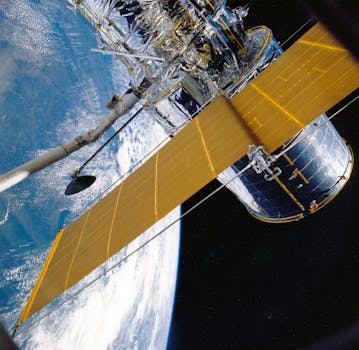
The Rise of Mega-Constellations: Latest Updates in Satellite Telecommunications
The Focus Keyword is The Rise of Mega-Constellations, and it is an exciting time for the field of satellite telecommunications, with the rise of mega-constellations being a major development. Mega-constellations refer to a large group of satellites that work together to provide global coverage and connectivity. In recent years, several companies have announced plans to launch thousands of satellites into orbit, with the goal of providing high-speed internet access to every corner of the globe.
One of the main drivers behind the rise of mega-constellations is the growing demand for global connectivity. With the increasing use of mobile devices and the internet, there is a need for reliable and fast connectivity, even in remote and underserved areas. Mega-constellations aim to fill this gap by providing a network of satellites that can offer high-speed internet access to anyone, anywhere in the world.
Key Players in the Mega-Constellation Market
Several companies are leading the charge in the mega-constellation market, including SpaceX, Amazon, and OneWeb. SpaceX, founded by Elon Musk, has been at the forefront of the mega-constellation trend, with its Starlink project aiming to launch up to 42,000 satellites into orbit. Amazon has also announced plans to launch a mega-constellation of its own, called Kuiper Systems, which will consist of 3,236 satellites. OneWeb, meanwhile, has already launched several hundred satellites as part of its own mega-constellation, with the goal of providing global internet coverage by 2025.
These companies, along with others, are investing heavily in the development of mega-constellations, with the goal of providing a range of services, including broadband internet, mobile connectivity, and Earth observation. The rise of mega-constellations is also driving innovation in the field of space technology, with companies developing new types of satellites, launch systems, and ground equipment to support these large-scale satellite networks.
Benefits and Challenges of Mega-Constellations
The rise of mega-constellations has the potential to bring numerous benefits, including improved global connectivity, increased access to information, and new opportunities for economic development. Mega-constellations can also provide backup connectivity in the event of natural disasters or other crises, helping to keep people connected and informed.
However, the rise of mega-constellations also poses several challenges, including the risk of space debris, increased congestion in Earth’s orbit, and concerns over the environmental impact of large-scale satellite launches. There are also regulatory challenges, as governments and international organizations work to develop new rules and guidelines to govern the use of mega-constellations.
Future of Mega-Constellations
As the market for mega-constellations continues to evolve, we can expect to see new developments and innovations in the field of satellite telecommunications. The rise of mega-constellations is likely to have a significant impact on the way we communicate and access information, with the potential to bring numerous benefits to individuals, communities, and societies around the world.
However, it is also important to address the challenges posed by mega-constellations, including the need for sustainable and responsible practices in the development and launch of these large-scale satellite networks. As the industry continues to grow and evolve, it will be important to prioritize the development of new technologies and strategies that can help to mitigate the risks and challenges associated with mega-constellations.



